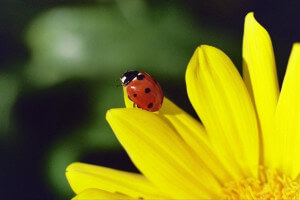
Gardeners turn to biological control (PDF) for help and to reduce or eliminate the need for chemical pesticides. These insects are the natural enemies of garden pests. That’s great news for growers because it means there is an effective, non-toxic approach for solving your bug blues. But the benefits don’t stop there!
Beneficial Insects
Beneficial insects feast on aphids, mites, caterpillars and other plant-consuming bugs and are harmless to people, plants and pets. For best results, release beneficial insects at the first sign of a problem. If pest populations are high, use the least-toxic, short-lived natural pesticide — Insecticidal Soaps, Horticultural Oils, Botanical Insecticides — to establish control before releasing predators/parasites.
Lady Bugs
 Ladybugs, or lady beetles (Hippodamia convergens) are the best known garden predators available. Both the adult and their dark gray and orange marked larvae feed on aphids (40-50 per day) and a wide variety of other soft-bodied pests, mites and insect eggs.
Ladybugs, or lady beetles (Hippodamia convergens) are the best known garden predators available. Both the adult and their dark gray and orange marked larvae feed on aphids (40-50 per day) and a wide variety of other soft-bodied pests, mites and insect eggs.
- Native ladybugs do not bite nor do they go into your home
- Only eat aphids and other soft bodied pest insects and insect eggs including aphids
- Upon purchase place your ‘Ladies’ in the fridge and release only in the evening
- Water the area before releasing your ladybugs
- Placing a small dish of water in your garden will help keep not only ladybugs but native insects close to your plants especially in soaring heat
- Eggs are white or yellow ovals and are laid in clusters
- Larvae are black and orange alligator shaped.
- Both the adult and larvae stage are great general pest controllers.
- Adult ladybugs can eat up to a 1000 aphids a day and as a larvae, about half as many.
- 2,000 ladybugs can cover up to 1,000 sq ft.
Let bugs do your dirty work
Release biocontrols, both as a preventative and as a control measure. Also, attract natural predators to your garden by planting a row or border of “insectary plants.” Fennel, calendula, coriander, dill, and cosmos are all considered good plants for attracting beneficials.





Leave a Reply
You must be logged in to post a comment.